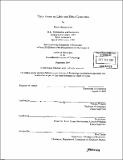Three essays on labor and urban economics
Author(s)
Lewis, Mark Johnson, 1975-
DownloadFull printable version (4.408Mb)
Other Contributors
Massachusetts Institute of Technology. Dept. of Economics.
Advisor
William Wheaton and Dafid Autor.
Terms of use
Metadata
Show full item recordAbstract
This thesis consists of three unrelated essays in the fields of labor and urban economics. The first essay exploits the creation of a formal college system in Quebec in the late 1960's as a quasi-experiment to estimate the value of community college. Focusing on the effect of the policy on English-speaking Quebecois, the creation of the CEGEPs (Colleges of General and Vocational Education) is shown to increase schooling by about a third of a year for both men and women, without diverting students from university. Despite increasing educational attainment, estimates of the impact of CEGEP on wages are negative. Analysis suggests the negative estimates can be understood as a combination of lost labor market experience, a decrease in the return to university, and an insignificant return to CEGEP. The results are robust to the inclusion of controls and across years of data. Possible interpretations of the results are discussed. The second essay, co-authored with William Wheaton, examinesthe relationship between labor market agglomeration and wages. Using the 5% public use micro sample of the 1990 U.S. census, we find that observationally equivalent workers in the manufacturing sector earn higher wages when they are in urban labor markets that have a larger share of national or metropolitan employment in their same occupation and industry groups. Quantitatively, the effect is large, with an elasticity (measured at the means) of between 1.2 and 3.6 for these effects. We interpret the willingness of firms to pay more for equivalent workers in dense markets as evidence of an agglomeration economy in urban labor. The third chapter estimates the effect of employment dispersion on average commute times in American cities. Using a sample of over two hundred cities, I find that residents of cities where employment is more geographically disperse have lower average commute times than residents of cities where employment is more centralized. The results are robust to theinclusion of city fixed effects. An instrumental variables strategy is employed to try to account for potential simultaneity between changes in employment dispersion and changes in commute times.
Description
Thesis (Ph. D.)--Massachusetts Institute of Technology, Dept. of Economics, 2003. Includes bibliographical references.
Date issued
2003Department
Massachusetts Institute of Technology. Department of EconomicsPublisher
Massachusetts Institute of Technology
Keywords
Economics.